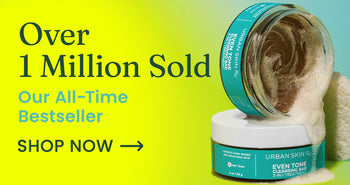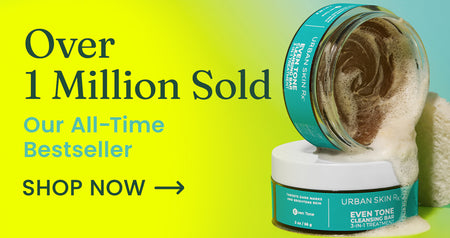How To Use Niacinamide and Vitamin C for Best Results

When it comes to designing your skincare routine, the best place to start is by making a list of the issues you’d like to tackle.
There are so many skincare products that are advertised as game changers for every skin complaint — and while maybe, sometimes, that’s actually true, the most important thing to pay attention to when you’re choosing products is the ingredients.
But when you break down every possible serum, for instance, and every single ingredient in those serums… it gets overwhelming quickly. There aren’t enough spreadsheets in the world. Also, we don’t want to make spreadsheets.
Sometimes, then, it’s best to focus on the heavy-hitter ingredients that get mentioned frequently by companies, dermatologists and beauty bloggers alike and really get to know those ingredients before you get around to choosing your products.
Two skincare heroes that are mentioned all the time are Niacinamide and Vitamin C. You probably see these two babes pop up most when you’re looking for ways to brighten your complexion and reduce visible signs of aging.
But while you may have an idea of what these ingredients are intended to do, and you may even have a couple of products containing them on your wishlist, before you start subbing them into your skincare lineup, let’s talk about what they actually do and how best to get these products to work together to help you get that glow up.
What Is Niacinamide?
Niacinamide comes up a lot when it comes to skincare. It’s been around for a long time as far as skincare ingredients go.
It gets a lot of praise when it comes to things like minimizing the appearance of your pores, regulating sebum, reducing the appearance of hyperpigmentation and even reducing the appearance of any fine lines and wrinkles you may have… so just a few things! No biggie.
You may have seen Niacinamide used interchangeably with the word Niacin. While the two are both derived from Vitamin B-3, they aren’t exactly the same — your body can produce Niacinamide from Niacin, however, so taking B-3 supplements might still benefit your skin. Niacinamide is a form of Vitamin B-3. B-3 is known to be good for your skin and even for your kidneys and brain.
Niacinamide may reduce skin irritation, redness or blotchiness, which is useful in treating frustrating skin conditions like acne and eczema when applied topically. It’s also thought to help regulate the amount of oil your skin produces, so if oiliness is a skin concern for you, this is your stop. Niacinamide has a bevy of other benefits, which are thought to include reducing the appearance of aging, minimizing the appearance of pores and even helping to improve your lipid barrier, which helps keep your skin plump and moisturized.
What Is Vitamin C?
Vitamin C is known for being a magical elixir, and it’s lauded for how it’s thought to even out your complexion and help give you a healthy glow.
You may be wondering why you need to apply Vitamin C to your face if you already get it in your diet — well, it’s because Vitamins you consume are distributed throughout different parts and processes within our bodies. There’s no way to guarantee that the orange you ate in your car this morning is going to make its way to your skin.
Using Vitamin C topically promotes several things we all want from our skin. It’s thought to help with hydration and overall skin brightness and may even stimulate collagen production. It’s also thought to be helpful in evening out your skin tone, so you may have been recommended topical Vitamin C before if you struggle with redness or hyperpigmentation.
How Do They Work Together?
If both of these ingredients seem like things you’d like to work into your routine, but you’re worried about using them together, don’t! Niacinamide and Vitamin C actually work very well together.
Although they target similar issues, they target these issues in slightly different ways. It’s like having two armies fighting the battle for you instead of one, which we think we can all agree sounds better.
Let’s say you’re looking to brighten up your complexion overall to get your glowy-est glow yet. Vitamin C is great for that because it inhibits a process that produces pigment — especially if you’re looking to reduce the appearance of hyperpigmentation in addition to getting a good all-around glow.
Niacinamide is also useful for brightening and evening out your skin tone, but rather than inhibiting certain processes; it actually gets in the way of how cells transfer pigment between one another, preventing the pigment from finding a home on your face (or other parts of your skin.)
The result is the same either way, but by using Niacinamide and Vitamin C, you’re getting double the benefit, with no overlap. Some ingredients may get the same results because they have the same effect, so using both would cancel out. Not so with Niacinamide and Vitamin C!
And if you’re concerned about a negative interaction from using Niacinamide and Vitamin C at the same time, rest assured, your face is in safe hands. Although applying Vitamin C topically comes with a wide variety of benefits, Vitamin C can be found on your skin naturally. So if Niacinamide had a negative reaction to Vitamin C… it wouldn’t be possible to use it for skincare at all.
How Do You Use Niacinamide and Vitamin C?
There are products available that combine Niacinamide and Vitamin C, so you know they go well together. Suppose you’d like to make use of both ingredients without adding fifteen minutes to your routine.
In that case, something like our Resurfacing Vitamin C Cleansing Bar with Niacinamide is a great replacement for your current face wash. It doesn’t just cleanse but gives your face a resurfacing and a burst of those amazing ingredients to help keep you clean, clear and bright AF.
If you want something that will stick with your skin a little longer, you could work Niacinamide and Vitamin C into your routine with a serum. Our Even Tone Super Glow Serum contains both Niacinamide and Vitamin C, along with several other super nourishing ingredients. You’ll want to use a serum after cleansing and before moisturizing, so it’s best to apply your serum in the morning before your makeup or in the evening before you apply your night cream.
Niacinamide is also a common ingredient in toners. Toners are sometimes forgotten when it comes to putting together your skincare routine — as opposed to key components like moisturizers and cleansers. Still, they serve the crucial purpose of making sure your skin is completely clean and primed for whatever you’re going to apply next. Toner can also make your skin more receptive to serums. So if you’d rather keep the two ingredients separate, you could combine a Niacinamide toner with our Super C Brightening Serum to get the benefit of both products.
While Vitamin C tends to be super gentle on the skin, it’s always a good idea to introduce your face to new ingredients slowly. Start by applying the serum a couple of days a week, and if you’re feeling good, you can work up to using it daily to get the full effects of whatever ingredients your serum is made up of.
While Niacinamide and Vitamin C promise significant benefits, it’s also key to give your products a chance to work and use them consistently for a long period to get the full advantages.
Lastly, it’s always important to wear sunscreen — but it’s even more important to load up on SPF when you’re using concentrated serums like Vitamin C, which can be made less effective by long-term exposure to the sun and heat. And anyway, if you’re trying to reduce visible signs of aging or dial back your hyperpigmentation, SPF is important. You don’t want to undo all of your hard work!
In Conclusion
Niacinamide and Vitamin C are always at the top of the list of super skin healthy ingredients for a wide range of skin complaints and conditions. And unlike some ingredients, they actually work super well together because they target certain issues from slightly different angles.
Using both at once can be a powerful treatment for signs of aging, hyperpigmentation, oily skin and other types of redness or skin irritation. Whether you use a product that combines the two ingredients or work two different products into your routine to get double the benefits, we think this is a match made in heaven. And if you’re looking for a glow that’s just a few watts shy of heavenly, well, what could be better?
Service Representative




